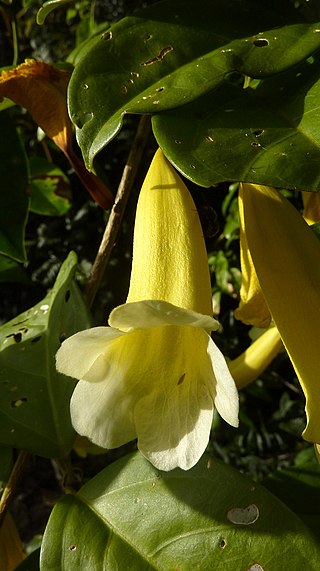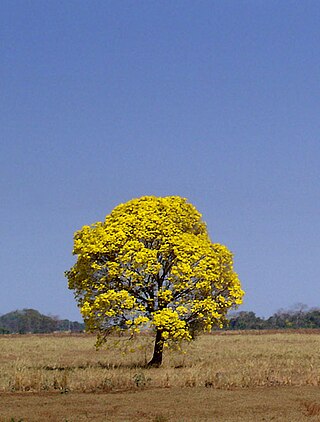
Tabebuia is a genus of flowering plants in the family Bignoniaceae. Tabebuia consists almost entirely of trees, but a few are often large shrubs. A few species produce timber, but the genus is mostly known for those that are cultivated as flowering trees.

Bignoniaceae is a family of flowering plants in the order Lamiales commonly known as the bignonias or trumpet vines. It is not known to which of the other families in the order it is most closely related.

Jacaranda is a genus of 49 species of flowering plants in the family Bignoniaceae, native to tropical and subtropical regions of the Americas while cultivated around the world. The generic name is also used as the common name.

Bignonia is a genus of flowering plants in the family Bignoniaceae. Its genus and family were named after Jean-Paul Bignon by his protégé Joseph Pitton de Tournefort in 1694, and the genus was established as part of modern botanical nomenclature in 1753 by Carl Linnaeus. Species have been recorded from the southern USA, Central to most of South America.

Rhododendron subgenus Rhododendron is a subgenus of the genus Rhododendron. With around 400 species, it is the largest of the eight subgenera containing nearly half of all known species of Rhododendron and all of the lepidote species.

Anemopaegma is a genus of flowering plants in the family Bignoniaceae. Species of Anemopaegma along with many other unrelated plants go by the name of catuaba.

Mansoa is a genus of tropical, flowering vines in the family Bignoniaceae.

Markhamia is a genus of flowering plants in the family Bignoniaceae; species are recorded from Africa and South-East Asia. The genus is named after Clements Markham.

Handroanthus is a genus of flowering plants in the family Bignoniaceae. It consists of 30 species of trees, known in Latin America by the common names poui, pau d'arco, or ipê. The latter sometimes appears as epay or simply ipe (unaccented) in English. The large timber species are sometimes called lapacho or guayacan, but these names are more properly applied to the species Handroanthus lapacho and Handroanthus guayacan, respectively.

Roseodendron is a genus of flowering plants in the family Bignoniaceae. It consists of two species, Roseodendron donnell-smithii and Roseodendron chryseum. The type species for the genus is R. donnell-smithii. Both species are cultivated as ornamentals for their numerous, large, yellow flowers.

Astianthus is a monotypic genus of flowering plants in the Bignoniaceae family. The sole species is Astianthus viminalis. It is known by the common names achuchil in Mexico and chilca in Guatemala and Honduras.

Amphilophium is a genus of flowering plants in the family Bignoniaceae, native to South America. Amphilophium crucigerum has escaped from cultivation elsewhere, and has become an invasive weed in Australia.

Tanaecium is a genus of flowering plants in the family Bignoniaceae, native to south and Central America.
Pleonotoma is a genus of tropical, flowering lianas located in the family Bignoniaceae.

Dolichandra is a genus of flowering plants in the family Bignoniaceae, native to Latin America and the Caribbean. They are climbing lianas with trifid and uncate tendrils. The best-known species is Dolichandra unguis-cati.
Xylophragma is a genus of flowering plants in the family Bignoniaceae, native to dry forests of Mexico, Central America, Trinidad and northern South America. They are lianas or scandent shrubs.

Heterophragma is a genus of two species of tree, constituting part of the plant family Bignoniaceae. The species are found in Southeast Asia and India.
Pachyptera is a genus of flowering plants belonging to the family Bignoniaceae.

Gaya is a genus of flowering plants belonging to the family Malvaceae. It has been classed in the Malvoideae subfamily and the Malveae tribe.
Adenocalymma arthropetiolatum is a species of flowering plant in the family Bignoniaceae, native to Panama and northwestern Colombia. A liana, it is found growing from sea level to 100 m (330 ft) in elevation.
















